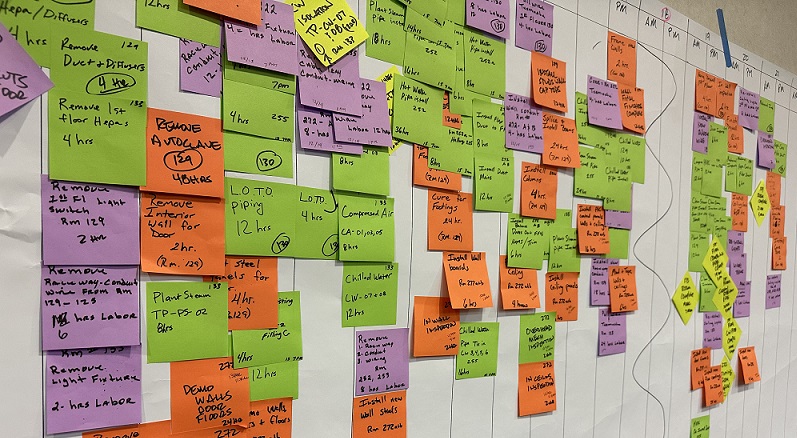
Lean Construction Principles More Important Than Ever
The construction industry has seen a lot of change and numerous innovative approaches introduced over the last 20 or so years. Building Information Modeling (BIM) and Lean Construction are two of the most notable. For advanced construction companies, both initiatives have now been around long enough that they are simply a part of normal day-to-day business operations. However, there is a distinct difference between BIM and Lean Construction when it comes to driving adoption and advancement. BIM is primarily technology-driven, whereas Lean Construction is more behavior-driven. While driving the adoption of new technology has its challenges, I believe most will agree that changing human behavior is typically the more difficult journey. Dr. Henry Cloud, acclaimed leadership expert, clinical psychologist, and New York Times bestselling author, has written, “We change our behavior when the pain of staying the same becomes greater than the pain of changing. Consequences give us the pain that motivates us to change.”
I remember when Lean Construction principles were first coming onto the scene. At the time, I was knee-deep and up to my elbows in personal education to become a Lean Construction advocate and trainer with the hope of driving positive behavioral change on my projects. Speaking candidly, the Lean Construction journey in our industry has been met with more challenges and pushback than I had hoped to see. That’s probably because, when fully integrated, Lean Construction has many behavioral components, from performing Daily Huddles, to Managing Constraints, to implementing the Last Planner® System, to name a few. As with many aspects of our industry, none of these components/tools operate in a silo. Each one is mutually dependent on or associated with at least one other component/tool of Lean Construction — all with the ultimate goal of eliminating waste and improving workflow to produce increased efficiencies, quality, and predictability, and to foster a culture of continuous improvement and respect for everyone involved on our projects.
Remembering Dr. Cloud’s quote, while adopting Lean Construction principles industry-wide on projects has been slower than preferred, I believe we have a unique opportunity today within the present market environment to drive and promote their adoption. Let’s use Managing Constraints, previously mentioned, as an example. Rarely in my 40 years in this industry have I witnessed a time where managing constraints due to pricing and supply chain volatilities has been more important. Today, we are seeing some long-lead material deliveries extending beyond 12 months and some material pricing more than doubling from just two short years ago. If there ever was a moment of “pain” that provides the opportunity to motivate us to positive change, today is one of those days.
Managing Constraints associates with multiple other Lean Construction components/tools. Two that come to mind are Daily Huddles and the Last Planner System (including Pull Planning), also previously mentioned. Daily Huddles ensure that all key team members, including trade crews, share full-circle communication with one another at the beginning of each day to review the day’s work and to address and manage potential constraints. The Last Planner System turns the traditional Critical Path Method (CPM) push scheduling approach on its ear, viewing and managing the schedule from the end rather than the beginning to also address and manage potential constraints.
Our project teams use many Lean Construction tools and techniques to effectively manage project constraints more efficiently providing greater predictability. Applying Lean Construction principles, we continuously develop and track material deliveries with our trade partners enabling us to rapidly respond to conflicts before any setbacks can negatively impact a project. We incorporate this information within our weekly schedule updates so we can adjust accordingly and best respond to everchanging supply chain conditions.
Additionally, we engage in daily project team huddles to review current and new constraints involving design and field conditions, material deliveries and labor challenges, requests for information, and change management. These huddles are also used to provide status updates to the entire project team. Our Lean approach promotes seamless communication and attention to items that could affect the work’s progress, while at the same time keeping these issues front and center for prompt resolution.
Often, we must explore alternate material options due to manufacturing and supply chain delays to ensure schedule compliance is maintained. The earlier we can communicate these alternates to clients, the better. Due to recent early detection of issues and constraints produced by current market conditions on many of our projects, we have been successful providing key solutions for a number of delayed materials and systems including roofing, switchgear, mechanical equipment, control panels, and flooring, to name a few.
Lean Construction principles, like the ones mentioned above, require behavioral shifts among all project team members involved to promote adoption. Rarely do we have opportunities like we do today to allow the pain of the present to drive the change we so desperately need for our industry’s future. I encourage everyone reading this article not to miss the key opportunity to embrace Lean Construction principles on every project.
About the Author – Gary Williams is Vice President for BE&K Building Group (bekbg.com) and leads the company’s Research Triangle Park regional business unit. He delivers nearly 40 years of construction management experience. A graduate of Purdue University, Gary holds a Bachelor of Science in Construction Engineering Technology. For more information, please contact Gary Williams at gary.williams@bekbg.com.






